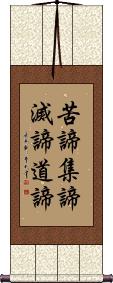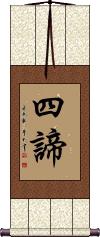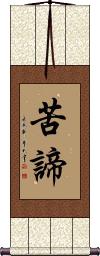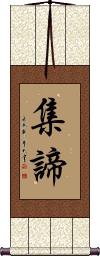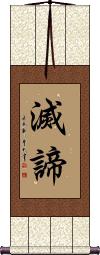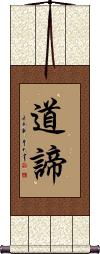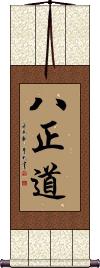Many custom options...
And formats...

Magga in Chinese / Japanese...
Buy a Magga calligraphy wall scroll here!
Personalize your custom “Magga” project by clicking the button next to your favorite “Magga” title below...
2. Four Noble Truths: Suffering
3. Four Noble Truths: Desire and Attachment
4. Four Noble Truths: Elimination of Desire or Attachment
Four Noble Truths (Full List)
苦諦集諦滅諦道諦 is the list of tenets of the Four Noble Truths as taught in virtually all sects of Buddhism.
They are suffering (dukkha), desire/attachment (samudaya), release from desire/attachment (nirodha), and the path leading away from suffering (magga).
Four Noble Truths (Buddhism)
四諦 is the title of the Four Noble Truths as taught in virtually all sects of Buddhism.
These truths are suffering (dukkha), desire/attachment (samudaya), release from desire/attachment (nirodha), and the path leading away from suffering (magga).
The suggestion behind these truths is that all things in nature suffer. All things in nature have desire and attachment for things in the physical world. The enlightened can release themselves from the bonds of desire and attachment. And finally, once they release all desire and attachment, the enlightened will find a path that leads away from suffering.
This term is exclusively used by devout Buddhists. It is not a common term, and is remains an unknown concept to most Japanese, Chinese, and Korean people.
See Also: Buddhism | Enlightenment
Four Noble Truths: Suffering
Dukkha
苦諦 relays that part of life in this universe is suffering.
All living things experience some form of suffering, according to Buddhist teaching.
This title is about accepting and understanding that the world is full of suffering.
This term is exclusively used by devout Buddhists. It is not a common term, and is remains an unknown concept to most Chinese, Japanese and Korean people.
See Also: Buddhism | Enlightenment
Four Noble Truths: Desire and Attachment
Samudaya
集諦 represents the idea that the core of suffering is often the concept of desire or attachment.
This can be carnal desire, monetary desire, or the attachment you have to something that you are unwilling to part with (such as a fancy car). 集諦 is a simplification of the second noble truth which is an exploration into the root causes of suffering - it's deeper than I can go in a few sentences.
This term is exclusively used by devout Buddhists. It is not a common term, and is remains an unknown concept to most Chinese, Japanese and Korean people.
See Also: Buddhism | Enlightenment
Four Noble Truths: Elimination of Desire or Attachment
Nirodha
滅諦 suggests that once you eliminate desire or attachment to worldly things, only then can you achieve enlightenment.
Realize that things are impermanent. That fancy car, beautiful spouse, big house, and impressive career are things you can't take with you. These things are a flash in the pan compared to the infinite span of history, generations to come, time, and space.
This term is exclusively used by devout Buddhists. It is not a common term, and is remains an unknown concept to most Japanese, Korean, and Chinese people.
See Also: Buddhism | Enlightenment
Four Noble Truths: Path Leading Away From Suffering
Magga
道諦 is the idea that once you have dealt with your desires and left all desire and attachment behind, only then are you on the path away from suffering (and on your way to enlightenment).
道諦 is also called the path to liberation in some English texts on Buddhism.
This term is exclusively used by devout Buddhists. It is not a common term, and is remains an unknown concept to most Chinese, Japanese and Korean people.
See Also: Buddhism | Enlightenment
The Noble Eightfold Path
Ashtangika Marga / Astangika-Marga / Atthangika Magga
八正道 is a complex set of steps that Buddhists much take to cleanse karma, achieve enlightenment, eventually cease the cycle of rebirth and live in a state of Nirvana.
Note: This term is exclusively used by devout Buddhists. It is not a common term and remains an unknown concept to most Japanese and Chinese people. Sometimes written as 八聖道.
See Also: Buddhism | Enlightenment
Not the results for magga that you were looking for?
Below are some entries from our dictionary that may match your magga search...
| Characters If shown, 2nd row is Simp. Chinese |
Pronunciation Romanization |
Simple Dictionary Definition |
鹿 see styles |
lù lu4 lu roku ろく |
More info & calligraphy: Deerdeer (esp. the sika deer, Cervus nippon); cervid; (personal name) Roku mṛga; a deer; as Śākyamuni first preached the four noble truths in the Deer-garden, the deer is a symbol of his preaching. |
四諦 四谛 see styles |
sì dì si4 di4 ssu ti shitai したい |
More info & calligraphy: Four Noble Truths (Buddhism){Buddh} (See 苦集滅道) The Four Noble Truths catvāri-ārya-satyāni; 四聖諦; 四眞諦. The four dogmas, or noble truths, the primary and fundamental doctrines of Śākyamuni, said to approximate to the form of medical diagnosis. They are pain or 'suffering, its cause, its ending, the way thereto; that existence is suffering, that human passion (taṇhā, 欲 desire) is the cause of continued suffering, that by the destruction of human passion existence may be brought to an end; that by a life of holiness the destruction of human passion may be attained'. Childers. The four are 苦, 聚 (or 集), 滅, and 道諦, i. e. duḥkha 豆佉, samudaya 三牟提耶, nirodha 尼棲陀, and mārga 末加. Eitel interprets them (1) 'that 'misery' is a necessary attribute of sentient existence'; (2) that 'the 'accumulation' of misery is caused by the passions'; (3) that 'the 'extinction' of passion is possible; (4) mārga is 'the doctrine of the 'path' that leads to the extinction of passion'. (1) 苦 suffering is the lot of the 六趣 six states of existence; (2) 集 is the aggregation (or exacerbation) of suffering by reason of the passions; (3) 滅 is nirvana, the extinction of desire and its consequences, and the leaving of the sufferings of mortality as void and extinct; (4) 道 is the way of such extinction, i. e. the 八正道 eightfold correct way. The first two are considered to be related to this life, the last two to 出世間 a life outside or apart from the world. The four are described as the fundamental doctrines first preached to his five former ascetic companions. Those who accepted these truths were in the stage of śrāvaka. There is much dispute as to the meaning of 滅 'extinction' as to whether it means extinction of suffering, of passion, or of existence. The Nirvana Sutra 18 says that whoever accepts the four dogmas will put an end to births and deaths 若能見四諦則得斷生死 which does not of necessity mean the termination of existence but that of continued transmigration. v. 滅. |
正見 正见 see styles |
zhèng jiàn zheng4 jian4 cheng chien masami まさみ |
More info & calligraphy: 1. Right Understanding / Right Perspective / Right View / Perfect Viewsamyag-dṛṣṭi, right views, understanding the four noble truths; the first of the 八正道; 'knowledge of the four noble truths. ' Keith. |
五乘 see styles |
wǔ shèng wu3 sheng4 wu sheng gojō |
The five vehicles conveying to the karma reward which differs according to the vehicle: they are generally summed up as (1) 入乘 rebirth among men conveyed by observing the five commandments; (2) 天乘 among the devas by the ten forms of good action; (3) 聲聞乘 among the śrāvakas by the four noble truths; (4) 緣覺乘 among pratyekabuddhas by the twelve nidānas; (5) 菩薩乘 among the Buddhas and bodhisattvas by the six pāramitās 六度 q. v. Another division is the various vehicles of bodhisattvas; pratyekabuddhas; śrāvakas; general; and devas-and-men. Another is Hīnayāna Buddha, pratyekabuddhas, śrāvakas, the gods of the Brahma heavens, and those of the desire-realm. Another is Hīnayāna ordinary disciples: śrāvakas: pratyekabuddhas; bodhisattvas; and the one all-inclusive vehicle. And a sixth, of Tiantai, is for men; devas; śrāvakas-cum-pratyekabuddhas; bodhisattvas: and the Buddha-vehicle. The esoteric cult has: men, corresponding with earth; devas, with water: śrāvakas, with fire: pratyekabuddhas, with wind; and bodhisattvas, with 空 the 'void'. |
五時 五时 see styles |
wǔ shí wu3 shi2 wu shih goji |
(五時教) The five periods or divisions of Śākyamuni's teaching. According to Tiantai they are (1) 華嚴時 the Avataṃsaka or first period in three divisions each of seven days, after his enlightenment, when he preached the content, of this sutra; (2) 鹿苑時 the twelve years of his preaching the Āgamas 阿含 in the Deer Park; (3) 方等時 the eight years of preaching Mahāyāna-cum-Hīnayāna doctrines, the vaipulya period; (4) 般若時 the twenty-two years of his preaching the prajñā or wisdom sutras; (5) 法華涅槃時 the eight years of his preaching the Lotus Sutra and, in a day and a night, the Nirvana Sutra. According to the Nirvana School (now part of the Tiantai) they are (1) 三乘別教 the period when the differentiated teaching began and the distinction of the three vehicles, as represented by the 四諦 Four Noble Truths for śrāvakas, the 十二因緣 Twelve Nidānas for pratyekabuddhas, and the 六度 Six Pāramitās for bodhisattvas; (2) 三乘通教 the teaching common to all three vehicles, as seen in the 般若經; (3) 抑揚教 the teaching of the 維摩經, the 思益梵天所問經, and other sutras olling the bodhisattva teaching at the expense of that for śrāvakas; (4) 同歸教 the common objective teaching calling all three vehicles, through the Lotus, to union in the one vehicle; (5) 常住教 the teaehmg of eternal life i. e. the revelation through the Nirvana sutra of the eternity of Buddhahood; these five are also called 有相; 無相; 抑揚; 曾三歸—; and 圓常. According to 劉虬 Liu Chiu of the 晉 Chin dynasty, the teaching is divided into 頓 immediate and 漸 gradual attainment, the latter having five divisions called 五時教 similar to those of the Tiantai group. According to 法寶 Fabao of the Tang dynasty the five are (1) 小乘; (2) 般着 or 大乘; (3) 深密 or 三乘; (4) 法華 or 一乘; (5) 涅槃 or 佛性教. |
五諦 五谛 see styles |
wǔ dì wu3 di4 wu ti gotai |
The five axioms: (1) 因諦 the cause, which is described as 集諦 of the Four Noble Truths; (2) 果諦 the effect as 苦諦; (3) 智諦 or 能知諦 diagnosis as 道諦; (4) 境諦 or 所知諦 the end or cure as 滅諦; to these add (5) 勝諦 or 至諦, the supreme axiom, i. e. the 眞如; v. 四諦. |
八諦 八谛 see styles |
bā dì ba1 di4 pa ti hachitai |
The eight truths, postulates, or judgments of the 法相 Dharmalakṣana school, i.e. four common or mundane, and four of higher meaning. The first four are (1) common postulates on reality, considering the nominal as real, e.g. a pot; (2) common doctrinal postulates, e.g. the five skandhas; (3) abstract postulates, e.g. the four noble truths 四諦; and (4) temporal postulates in regard to the spiritual in the material. The second abstract or philosophical four are (5) postulates on constitution and function, e.g. of the skandhas; (6) on cause and effect, e.g. the 四諦; (7) on the void, the immaterial, or reality; and (8) on the pure inexpressible ultimate or absolute. |
十地 see styles |
shí dì shi2 di4 shih ti juuji / juji じゅうじ |
{Buddh} dasabhumi (forty-first to fiftieth stages in the development of a bodhisattva); (place-name) Jūji daśabhūmi; v. 十住. The "ten stages" in the fifty-two sections of the development of a bodhisattva into a Buddha. After completing the十四向 he proceeds to the 十地. There are several groups. I. The ten stages common to the Three Vehicles 三乘 are: (1) 乾慧地 dry wisdom stage, i. e. unfertilized by Buddha-truth, worldly wisdom; (2) 性地 the embryo-stage of the nature of Buddha-truth, the 四善根; (3) 八人地 (八忍地), the stage of the eight patient endurances; (4) 見地 of freedom from wrong views; (5) 薄地 of freedom from the first six of the nine delusions in practice; (6) 離欲地 of freedom from the remaining three; (7) 巳辨地 complete discrimination in regard to wrong views and thoughts, the stage of an arhat; (8) 辟支佛地 pratyeka-buddhahood, only the dead ashes of the past left to sift; (9) 菩薩地 bodhisattvahood; (10) 佛地 Buddhahood. v. 智度論 78. II. 大乘菩薩十地 The ten stages of Mahāyāna bodhisattva development are: (1) 歡喜地 Pramuditā, joy at having overcome the former difficulties and now entering on the path to Buddhahood; (2) 離垢地 Vimalā, freedom from all possible defilement, the stage of purity; (3) 發光地 Prabhākarī, stage of further enlightenment; (4) 焰慧地 Arciṣmatī, of glowing wisdom; (5) 極難勝地 Sudurjayā, mastery of utmost or final difficulties; (6) 現前地 Abhimukhī, the open way of wisdom above definitions of impurity and purity; (7) 遠行地 Dūraṁgamā, proceeding afar, getting above ideas of self in order to save others; (8) 不動地 Acalā, attainment of calm unperturbedness; (9) 善慧地 Sādhumatī, of the finest discriminatory wisdom, knowing where and how to save, and possessed of the 十力 ten powers; (10) 法雲地 Dharmamegha, attaining to the fertilizing powers of the law-cloud. Each of the ten stages is connected with each of the ten pāramitās, v. 波. Each of the 四乘 or four vehicles has a division of ten. III. The 聲聞乘十地 ten Śrāvaka stages are: (1) 受三歸地 initiation as a disciple by receiving the three refuges, in the Buddha, Dharma, and Saṅgha; (2) 信地 belief, or the faith-root; (3) 信法地 belief in the four truths; (4) 内凡夫地 ordinary disciples who observe the 五停心觀, etc.; (5) 學信戒 those who pursue the 三學 three studies; (6) 八人忍地 the stage of 見道 seeing the true Way; (7) 須陀洹地 śrota-āpanna, now definitely in the stream and assured of nirvāṇa; (8) 斯陀含地 sakrdāgāmin, only one more rebirth; (9) 阿那含地 anāgāmin, no rebirth; and (10) 阿羅漢地 arhatship. IV. The ten stages of the pratyekabuddha 緣覺乘十地 are (1) perfect asceticism; (2) mastery of the twelve links of causation; (3) of the four noble truths; (4) of the deeper knowledge; (5) of the eightfold noble path; (6) of the three realms 三法界; (7) of the nirvāṇa state; (8) of the six supernatural powers; (9) arrival at the intuitive stage; (10) mastery of the remaining influence of former habits. V. 佛乘十地 The ten stages, or characteristics of a Buddha, are those of the sovereign or perfect attainment of wisdom, exposition, discrimination, māra-subjugation, suppression of evil, the six transcendent faculties, manifestation of all bodhisattva enlightenment, powers of prediction, of adaptability, of powers to reveal the bodhisattva Truth. VI. The Shingon has its own elaborate ten stages, and also a group 十地十心, see 十心; and there are other groups. |
四眞 see styles |
sì zhēn si4 zhen1 ssu chen shishin |
(四眞諦) The four noble truths, v. 四諦 (四聖諦) , i. e. 苦, 集, 滅, 道 pain, its location, its cessation, the way of cure. |
聖諦 圣谛 see styles |
shèng dì sheng4 di4 sheng ti shōtai |
The sacred principles or dogmas, or those of the saints, or sages; especially the four noble truths, cf. 四聖諦. |
具知根 see styles |
jù zhī gēn ju4 zhi1 gen1 chü chih ken guchi kon |
faculty of the power of perfect knowledge [of the Four Noble Truths] |
初時教 初时教 see styles |
chū shí jiào chu1 shi2 jiao4 ch`u shih chiao chu shih chiao shojikyō |
A term of the 法相宗 Dharmalakṣana school, the first of the three periods of the Buddha's teaching, in which he overcame the ideas of heterodox teachers that the ego is real, and preached the four noble truths and the five skandhas, etc. |
四眞諦 四眞谛 see styles |
sì zhēn dì si4 zhen1 di4 ssu chen ti shi shintai |
four noble truths |
四眞道 see styles |
sì zhēn dào si4 zhen1 dao4 ssu chen tao shi shindō |
the path of the four noble truths |
四聖諦 四圣谛 see styles |
sì shèng dì si4 sheng4 di4 ssu sheng ti shishoutai / shishotai ししょうたい |
the Four Noble Truths (Buddhism); see also 四諦|四谛[si4 di4] and 苦集滅道|苦集灭道[ku3 ji2 mie4 dao4] {Buddh} (See 四諦) The Four Noble Truths The four holy or noble truths, idem 四諦. |
四諦經 四谛经 see styles |
sì dì jīng si4 di4 jing1 ssu ti ching Shitai kyō |
The sutra of the four dogmas, tr. by 安世高 An Shih Kao, one juan. 四趣 Durgati; the four evil directions or destinations: the hells, hungry ghosts, animals, asuras; v. 四惡. |
已知根 see styles |
yǐ zhī gēn yi3 zhi1 gen1 i chih ken ichi kon |
ājñendriya. The second of the 三無漏根 q. v. One who already knows the indriya or roots that arise from the practical stage associated with the Four Dogmas, i. e. purpose, joy, pleasure, renunciation, faith, zeal, memory, abstract meditation, wisdom. |
見諦者 见谛者 see styles |
jiàn dì zhě jian4 di4 zhe3 chien ti che kentia sha |
one who has clearly cognized the [four noble] truths |
諦現觀 谛现观 see styles |
dì xiàn guān di4 xian4 guan1 ti hsien kuan tai genkan |
to clear understanding of the [four noble] truths |
二十二根 see styles |
èr shí èr gēn er4 shi2 er4 gen1 erh shih erh ken nijūni kon |
The twenty-two roots, organs, or powers, v. 根. They are: (1) 眼根 eye, cakṣurindriya; (2) 耳 根 ear, śrotrendriya; (3) 鼻根 nose, ghrāṇendriya; (4) 舌根 tongue, jihvendriya; (5) 身根 body, kāyendriya; (6) 意根 mind, manaīndriya (the above are the 六根); (7) 女根 female organ, strīndriya; (8) 男根 male organ, puruṣendriya; (9) 命根 life, jīvitendriya; (10) 苦根 suffering (or pain), duḥkhendriya; (11) 樂根 pleasure, sukhendriya; (12) 憂根 sorrow, daurmanasyendriya; (13) 喜根 joy, saumanas-yendriya; (14) 捨根 abandoning, upekṣendriya (from 10 to 14 they are the 五受); (15) 信根 faith, śraddhendriya; (16) 精進根 zeal, vīryendriya; (17) 念根 memory, smṛtīndriya; (18) 定根 meditation, or trance, samādhīndriya; (19) 慧根 wisdom, prajñendriya (these are the 信等之五根); (20) 未知當知根 the power for learning (the Four Noble Truths) anājñātamājñāsyāmīndriya; (21) 巳知根 the power of having learned (them), ājñendriya; (22) 具知根 the power of perfect knowledge (of them), ājñātādvīndriya (these three are called the 無漏根) . |
二種因果 二种因果 see styles |
èr zhǒng yīn guǒ er4 zhong3 yin1 guo3 erh chung yin kuo nishuinka |
Two aspects of cause and effect, a division of the 四諦 "four noble truths" (a) 世間因果 in the present life, the 苦諦 being the effect, and the 集諦 the cause; (b) 出世間因果 in the future life, the 滅諦, extinction (of passion, or mortality) being the fruit, and the 道諦 the " eightfold noble path " the cause. |
四弘誓願 四弘誓愿 see styles |
sì hóng shì yuàn si4 hong2 shi4 yuan4 ssu hung shih yüan shi ku seigan |
The four universal vows of a Buddha or bodhisattva: 衆生無邊誓願度 to save all living beings without limit; 煩惱無數誓願斷 to put an end to all passions and delusions however numerous; 法門無盡誓願學 to study and learn all methods and means without end; 佛道無上誓願成 to become perfect in the supreme Buddha-law. The four vows are considered as arising one by one out of the 四諦 Four Noble Truths. |
四種四諦 四种四谛 see styles |
sì zhǒng sì dì si4 zhong3 si4 di4 ssu chung ssu ti sh ishu shitai |
four interpretations of Four [Noble] Truths |
四聖諦智 四圣谛智 see styles |
sì shèng dì zhì si4 sheng4 di4 zhi4 ssu sheng ti chih shi shōtai chi |
knowledge of the four noble truths |
尼彌留陀 尼弥留陀 see styles |
ní mí liú tuó ni2 mi2 liu2 tuo2 ni mi liu t`o ni mi liu to nimiruda |
nirodha, tr. as 滅 extinction, annihilation, cessation, the third of the four noble truths, cf. 尼樓陀. |
淸淨法眼 淸净法眼 see styles |
qīng jìng fǎ yǎn qing1 jing4 fa3 yan3 ch`ing ching fa yen ching ching fa yen shōjō hōgen |
The pure dharma-eye, with which the Hīnayāna disciple first discerns the four noble truths, and the: Mahāyāna disciple discerns the unreality of self and things. |
現觀四諦 现观四谛 see styles |
xiàn guān sì dì xian4 guan1 si4 di4 hsien kuan ssu ti genkan shitai |
through the realization of the four noble truths |
苦集滅道 苦集灭道 see styles |
kǔ jí miè dào ku3 ji2 mie4 dao4 k`u chi mieh tao ku chi mieh tao kujuumetsudou; kujumetsudou; kushumetsudou / kujumetsudo; kujumetsudo; kushumetsudo くじゅうめつどう; くじゅめつどう; くしゅめつどう |
the Four Noble Truths (Budd.), namely: all life is suffering 苦[ku3], the cause of suffering is desire 集[ji2], emancipation comes only by eliminating passions 滅|灭[mie4], the way 道[dao4] to emancipation is the Eight-fold Noble Way 八正道[ba1 zheng4 dao4]; also called 四諦|四谛[si4 di4] {Buddh} (See 四諦) Suffering, Source of Suffering Desire, The Cessation of Suffering, The Way Leading to the Cessation of Suffering (The Four Noble Truths of Buddhism) The four axioms or truths: i. e. duḥkha, pain; samudaya, as above; nirodha, the extinguishing of pain and reincarnation; mārga, the way to such extinction; cf. 四諦. |
佛說四諦經 佛说四谛经 see styles |
fó shuō sì dì jīng fo2 shuo1 si4 di4 jing1 fo shuo ssu ti ching Bussetsu shitai kyō |
Sūtra on the Four Noble Truths |
未知當知根 未知当知根 see styles |
wèi zhī dāng zhī gēn wei4 zhi1 dang1 zhi1 gen1 wei chih tang chih ken michi tōchi kon |
faculty of the power for learning [the Four Noble Truths] |
Click here for more magga results from our dictionary
The following table may be helpful for those studying Chinese or Japanese...
| Title | Characters | Romaji (Romanized Japanese) | Various forms of Romanized Chinese | |
| Four Noble Truths (Full List) | 苦諦集諦滅諦道諦 苦谛集谛灭谛道谛 | kutai jittai mettai doutai kutaijittaimettaidoutai kutai jittai mettai dotai | kǔ dì jí dì miè dì dào dì ku3 di4 ji2 di4 mie4 di4 dao4 di4 ku di ji di mie di dao di kudijidimiedidaodi | k`u ti chi ti mieh ti tao ti kutichitimiehtitaoti ku ti chi ti mieh ti tao ti |
| Four Noble Truths (Buddhism) | 四諦 四谛 | shitai | sì dì / si4 di4 / si di / sidi | ssu ti / ssuti |
| Four Noble Truths: Suffering | 苦諦 苦谛 | kutai | kǔ dì / ku3 di4 / ku di / kudi | k`u ti / kuti / ku ti |
| Four Noble Truths: Desire and Attachment | 集諦 集谛 | jittai | jí dì / ji2 di4 / ji di / jidi | chi ti / chiti |
| Four Noble Truths: Elimination of Desire or Attachment | 滅諦 灭谛 | mettai | miè dì / mie4 di4 / mie di / miedi | mieh ti / miehti |
| Four Noble Truths: Path Leading Away From Suffering | 道諦 道谛 | doutai / dotai | dào dì / dao4 di4 / dao di / daodi | tao ti / taoti |
| The Noble Eightfold Path | 八正道 | hasshoudou / hashodo | bā zhèng dào ba1 zheng4 dao4 ba zheng dao bazhengdao | pa cheng tao pachengtao |
| In some entries above you will see that characters have different versions above and below a line. In these cases, the characters above the line are Traditional Chinese, while the ones below are Simplified Chinese. | ||||
Successful Chinese Character and Japanese Kanji calligraphy searches within the last few hours...
